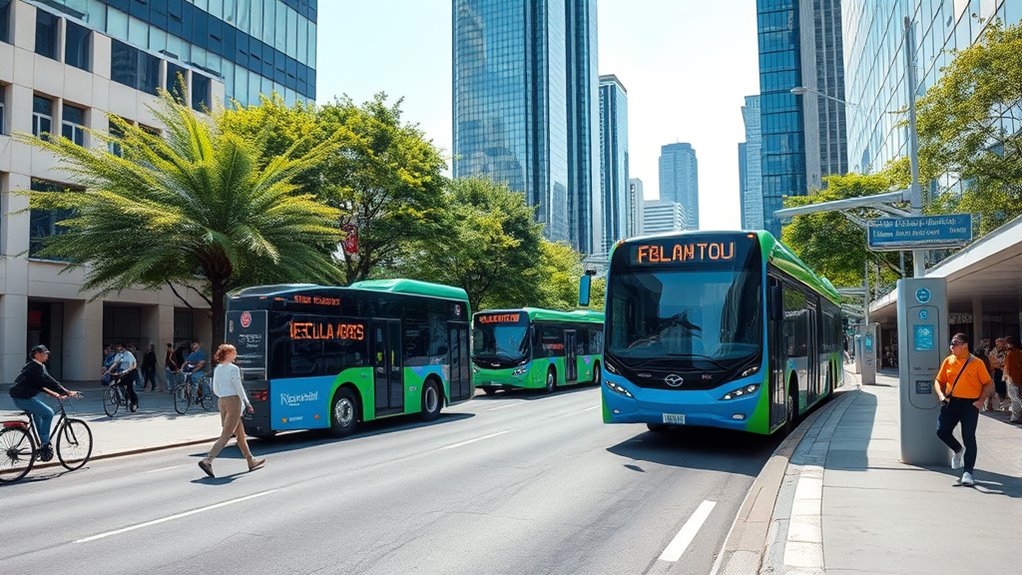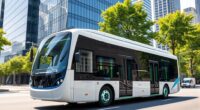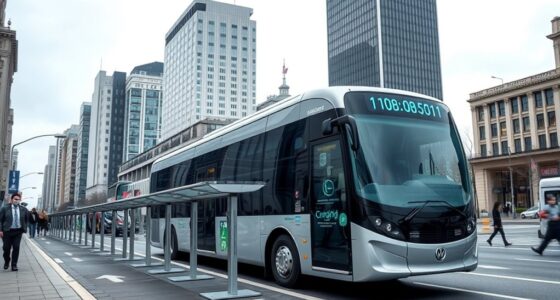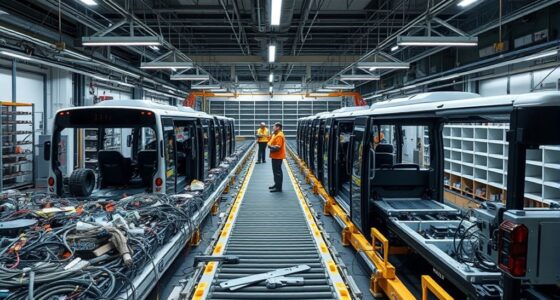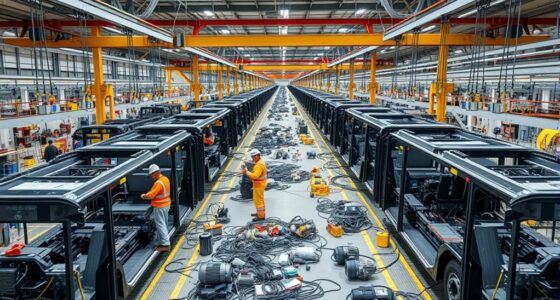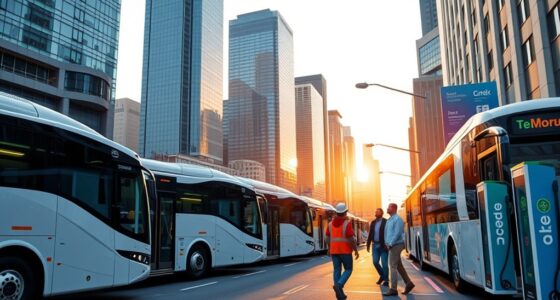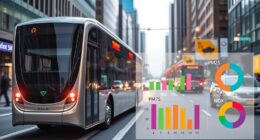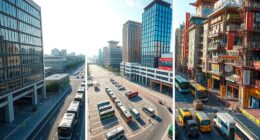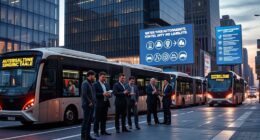Cities worldwide are adopting electric buses to cut emissions and improve air quality. Leading regions like China, Europe, and Latin America are rapidly expanding their fleets, supported by government policies, subsidies, and infrastructure investments. Innovations in battery tech make electric buses more efficient and affordable, encouraging more cities to join the shift to clean transportation. If you’re curious about how this global movement is evolving, there’s plenty more to explore.
Key Takeaways
- Cities worldwide are increasing electric bus fleets through policies, subsidies, and infrastructure investments to reduce emissions.
- Leading regions like China, Europe, and Latin America are expanding zero-emission bus adoption for cleaner urban air.
- Governments offer incentives such as subsidies and regulations to accelerate electric bus deployment in public transit.
- Advances in battery and charging technology enable longer ranges and faster charging, facilitating large-scale adoption.
- Urban areas are establishing zero-emission zones to promote cleaner transportation and improve public health.
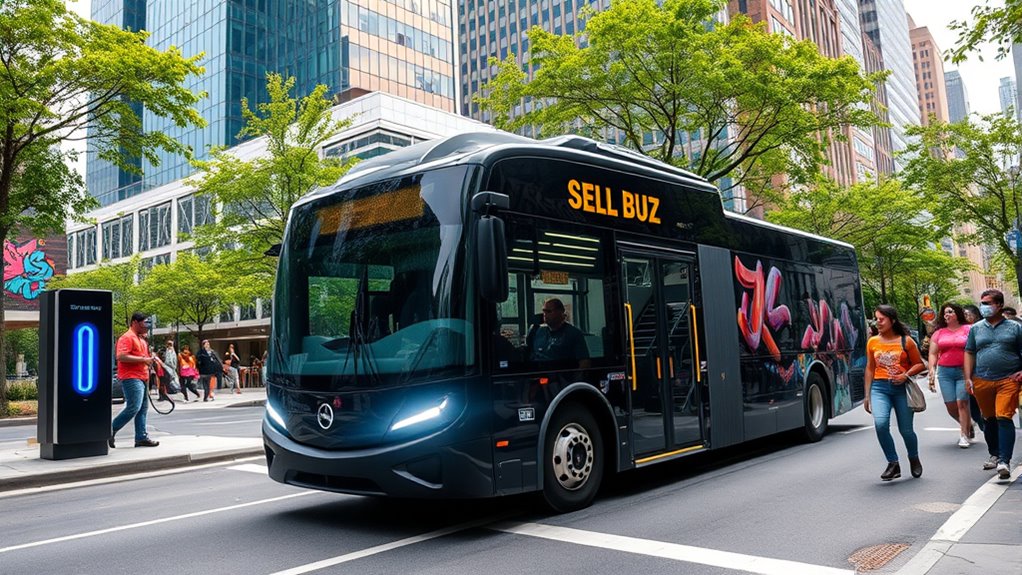
Cities around the world are rapidly shifting to electric buses to create cleaner, more sustainable public transportation systems. You’ll notice that China has been a global leader in this evolution, with Shenzhen reaching 100% electrification of its bus fleet since 2017. This move has led to significant reductions in CO₂ emissions and improved air quality. It’s a clear example of how aggressive adoption can have tangible environmental benefits.
China leads the way with Shenzhen’s fully electric bus fleet since 2017, reducing emissions and improving air quality.
Outside China, regions like Europe are making impressive strides. In 2023, electric bus registrations in Europe surged by 53%, and over 42% of city buses are now zero-emission. Cities across the continent are adopting policies and investing in infrastructure to accelerate this change, supported by government subsidies and technological advancements. The availability of aftermarket parts and upgrades further facilitates this transition, allowing cities to customize their fleets efficiently.
Latin American cities are also stepping up. Santiago and Medellín are actively shifting their fleets to electric, with Santiago aiming to become home to the second-largest electric bus fleet globally. These efforts are driven by a desire to reduce urban air pollution and meet climate commitments.
Meanwhile, emerging markets in Africa and the Middle East are recognizing the potential benefits. Countries like Kenya and Rwanda are investing in electric buses, driven by both environmental concerns and the need for affordable, reliable public transportation options.
You’ll see that the market is dominated by Asian manufacturers such as Yutong and BYD, which supply many of the electric buses worldwide. These companies continue to innovate in battery technology and charging solutions, making electric buses more efficient and easier to operate.
Governments play a vital role here, offering subsidies and policies that encourage adoption—examples include India’s FAME-II scheme or the EU’s “Fit for 55” initiative, which targets emission reductions and promotes electric mobility. Cities benefit from a competitive market where multiple providers offer electric buses, helping to lower costs and expand access.
The environmental impact of these shifts is profound. Electric buses significantly cut greenhouse gases and urban air pollution, directly benefiting public health. Cities establishing zero-emission zones are further pushing this agenda, creating cleaner environments for residents. Advances in battery technology are making electric buses more viable for large-scale deployment, ensuring longer ranges and shorter charging times.
These buses aren’t just about compliance; they’re about building healthier, more livable cities. As you observe these changes, it’s clear that electric buses are central to achieving sustainable public transportation goals worldwide. With continued support from policymakers and advances in technology, you can expect even more cities to embrace electric mobility in the near future, making transportation greener and cities better places to live.
Frequently Asked Questions
What Are the Main Challenges Cities Face When Implementing Electric Buses?
When you look at implementing electric buses, you’ll face several challenges. You might struggle with high upfront costs and outdated procurement policies that favor short-term savings.
Technological issues like limited battery range and long charging times can disrupt operations.
Infrastructure gaps, such as insufficient charging stations and grid limitations, also pose obstacles.
Additionally, institutional hurdles, including coordination between agencies and political risks, make moving forward complex but manageable with strategic planning.
How Do Electric Buses Impact Local Air Quality and Public Health?
You see, electric buses greatly improve local air quality and public health by reducing harmful emissions like particulate matter and ground-level ozone. They eliminate diesel exhaust, lowering respiratory and cardiovascular issues, especially for vulnerable populations.
Plus, quieter operation reduces noise pollution, enhancing urban living. These benefits lead to fewer healthcare costs and a healthier community overall, making your city cleaner, safer, and more livable.
What Financing Options Are Available for Cities to Fund Electric Bus Fleets?
Ever wondered how your city can afford electric buses? You have several options: tap into federal programs like NEVI for charging infrastructure, secure grants for vehicle costs, or use municipal bonds and taxes for funding.
Public-private partnerships and utility incentives can also lower expenses. With smart investments and innovative financing, you can accelerate the shift to cleaner, more sustainable transit.
Isn’t it time to prioritize green transportation?
How Do Electric Buses Perform in Extreme Weather Conditions?
You might wonder how electric buses handle extreme weather. In cold temperatures, they offer better stability and traction thanks to battery weight, but their range drops by about 33%.
In hot weather, efficiency can decrease unless proper cooling systems are used. To keep performance *ideal*, it’s essential to adapt routes, manage energy use, and schedule regular maintenance, ensuring your fleet runs smoothly regardless of weather conditions.
What Are the Long-Term Maintenance Costs of Electric Buses Compared to Diesel?
You’ll find that electric buses have considerably lower long-term maintenance costs than diesel buses. With fewer moving parts and no need for oil changes, exhaust repairs, or diesel-specific components, maintenance becomes simpler and cheaper.
Over time, you can expect about a 50% reduction in maintenance expenses, saving you between $4,000 and $11,000 per bus annually. Plus, less downtime and lower labor costs boost overall savings.
Conclusion
As cities continue to embrace electric buses, they’re creating cleaner, cooler, and more cost-effective communities. By boldly bridging borders, boosting sustainability, and banishing pollution, these urban upgrades showcase the power of progress. Remember, your city’s switch to sustainable transit isn’t just a trend—it’s a transformative step toward a cleaner climate. Stay inspired, stay involved, and support smarter, greener solutions that make every city a shining example of change.
